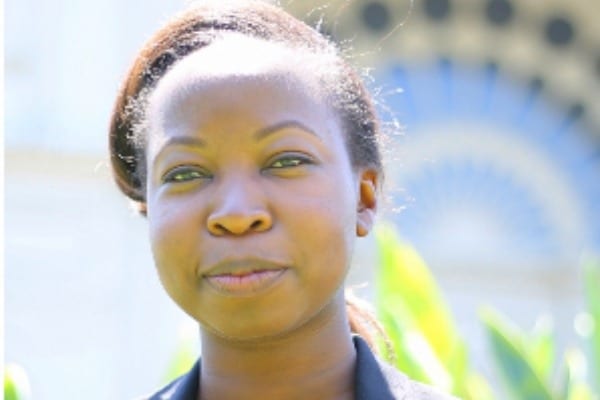“I think, for a while there, I actually thought maybe it’s mainly because of my personality, that I’m not aggressive enough,” she said earlier this year.
“But when you start hearing stories of other women of colour experiencing the same, of not progressing as quickly, or their salaries being disproportionate to their peers, then you start to realise, ‘Actually, I’m not going crazy. This is not just me. Other people are experiencing the same thing.'”
With her impressive trajectory of leadership roles, along with an influential and inspiring podcast among other accolades, Jere now works as a Senior Business Analyst at global technology consultancy, ThoughtWorks.
She also continues to share her concerns about diversity and equality in corporate Australia.
Recently, Jere spoke to Jessie Tu about her current work, how Australia can get more women participating in STEM, and the “ethnic pay gap”.
You’re the host of ‘The Art of Otherness’, a platform for open conversations on Otherness and fearless authenticity. What made you want to begin that podcast?
The podcast was born out of the need to hear from voices that were not presented in mainstream media. There are various people of colour whose voices are underrepresented and experiences are not heard. I believe for us to continue to strive for inclusion, we must learn and hear from everyone that is represented in our communities.
Most of us have something that differentiates us from others and sometimes it is awkward or uncomfortable to focus on it. The podcast is about allowing people to embrace their differences and have the power to walk in their own paths. It is about sharing wisdom that will empower people to be fearless in their authentic selves, especially when it is something difficult like race, sexual orientation, disability or gender, etc.
How do you think Australia can increase the participation of women in STEM?
We need to start early. Catching young women when they are in high school and deciding what to study at university is a bit too late. We need to cover the full lifespan of girls from when they start school to university, showing them industry role models so they can see all the different people they can be in STEM careers.
I love the work of organisations such as Industry Mentoring Network in STEM, ECOLINC GEMS: Girls in Engineering, Maths and Science Conference, Girls Who Code, Black Girls Code and Code Like a Girl.
They are showing our girls and young ladies the different roles they can take up in STEM and supporting them in growing their own STEM paths.
Parents also have a responsibility to encourage girls to take on science and mathematics because subjects like programming are not just for boys. We still have much to do in removing the misconception that STEM careers are male spaces. I would love to see the number of women in the Australian tech space grow from 28% (2018 Women in Tech Index.) to 50% in my lifetime.
How do you think the “ethnic pay gap” experienced by women affects their career progression?
The global gender report 2018 from the World Economic Forum says for countries in East Asia and the Pacific, which includes Australia, it will take 171 years for women to reach parity with men. This is more than two generations of children born today. It is not acceptable that in this day and age the stats on parity keep getting worse.
Research has shown that women from Culturally and Linguistically Diverse (CALD) backgrounds are most likely to not ask for a promotion and higher pay, believing that their hard work will bring those things eventually.
This is one of the factors that sees CALD women take longer to climb the leadership ladder, which then impacts their salary progression and increases the pay gap between them and their Anglo-Saxon counterparts. This also has an impact on their retirement funds.
How can companies and the rest of society overcome this issue?
It is paramount for companies to release statistics on how they are tracking in reducing the gender pay gap. With salaries being a taboo topic within companies, many get away from addressing this issue by not publishing their track record in closing the gap.It is not only on Equal Pay Day that we should bring up the issues of the gender/ethnic pay gap, but on a daily basis as we talk about recruitment, in pay review negotiations, when we distribute bonuses and when we map career development pathways.
If only we could make salaries less taboo, so that we can take leadership to task without feeling guilty about asking how much our male colleagues earn, or being shocked when we find our male counterpart’s pay-check at the printer.
As a society, we need to be conscious of those around us, in order to overcome the frustration and apathy towards difficult topics such as gender, race or sexual orientation etc.
How do you believe culturally diverse women can gain the confidence to ask for a pay rise and seize leadership opportunities?
CALD women should be empowered by their differences. You can increase your confidence and inspire other people of similar backgrounds to take the same journey by not blending in.
Our voices are our most powerful weapons. Culturally diverse women should share their experiences in the workplace so they can understand they are not the only ones and be able to unite with others in changing the status quo.
There is individual power that can be harnessed in companies to influence organisations into progressive attitudes. Don’t be afraid to tap into them. Don’t be afraid to showcase your hard work and ask for what you deserve. Pay negotiations are not easy for women, as we know, but not asking your worth is a disservice to your contributions in your teams.
How can those in positions of power (executives, CEOs, board members) encourage diversity?
Companies have a responsibility to foster safe spaces for people to share their experiences, as well as have their opinions respected and taken seriously. In addition to inclusion programmes, hiring strategies and other formalised training, leaders must encourage more voices to be heard in their policy-making. Women especially should have the safety to know that what they share will be believed and not seen as a gender tactic.
I have seen many diversity programs that are only about getting people through the door, with no support after.
Many leaders are just ticking the “we have done diversity” box. They must put in structures to ensure people are supported in their roles and that there are clear paths for career growth which ensure people don’t leave after they are through the door.
As Senior Business Analyst at global software consultancy, ThoughtWorks, what does a typical day look like for you?
As a Senior Business Analyst/Iteration Manager for ThoughtWorks, I lead medium to large sized teams. I work with client stakeholders to gain alignment on priorities, clarify the product strategy/roadmap in relation to the software being developed and ensure the team delivers on client expectations.
My typical day sees me facilitating sessions where the team and stakeholders get on the same page regarding requirements, technical implementation, user experience specifications, priorities, testing strategies and communicating the team’s progress.
On a day-to-day basis, I’m collaborating with Product Owners, UX Designers, Developers, Quality Analysts, Delivery Managers and Senior stakeholders to ensure the continuous delivery of working software using Agile methodology.
You lead “distribution teams” across Australia, China and India. What does that look like?
Distributed teams are teams that are not in the same location. For example, a team could have software developers in Chengdu in China, with Product Owners and Business Analysts in Melbourne. When people talk about offshore teams, this is a type of distributed team, where you have some people onshore and offshore.
As Iteration Manager, leading a software development team that is across multiple cities/countries can be a challenge due to cross-cultural and time zone differences, as well as language barriers. I have written about the importance of communication in building highly effective distributed teams here.
Leading distributed teams entails ensuring that everyone in the various locations feels part of the team; that they’re empowered to contribute equally in decisions, and that customers get high quality products.
My current team has people located in London and Chicago, with myself in Melbourne. Our main challenge has been finding a time that works for us all to have meetings that don’t entail someone being up at 2am.
What do you do to take care of yourself? Exercise? Hobbies? Movies? Books?
I have had to learn to slow down as a way of self-care, ensuring I have weekends where I am not running errands or attending events. I always make time to have a laugh with family and friends.
Arundhathi Roy is one of my favourite authors. Her book “Capitalism: A Ghost Story” is one of my favourites of hers. I’m currently reading “Who Owns the Future Anywhere” by Jaron Lanier – and a fun book that I read recently was “Stay With Me” by Ayobami Adebayo. Writing short stories, going on nature walks and hiking are my favourite past times. Writing is also my therapy whenever I need clarity or understanding of my next steps.
I’m lazy with exercise, but Pilates and HIIT training are usually my go-tos in my high-energy times.


